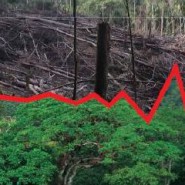Amazon States In Brazil Push For Benefit-Sharing On National REDD+ Strategy
Brazil aims to slash its greenhouse gas emissions 38% by 2020, with more than half of those reductions coming from an 80% reduction in Amazon deforestation. That makes REDD finance more important than ever – and bureaucratic deadlock more damaging. Amazon states say the whole process can be smoothed by splitting revenues and responsibilities 80/20 between the states and Brasilia.

12 March 2014 | Before relapsing in 2013, Brazil had slashed deforestation rates six years running – an achievement that meant 3.5 billion fewer tons of carbon dioxide escaping into the atmosphere than would have happened if they’d continued on their previous pace. That’s roughly 1/3 of the total amount the country has promised to reduce by 2020, but its winning streak ended when deforestation rates surged 28% last year.
The country still, however, says its deforestation rate will be 80% lower in 2020 than its average rate was from 1996 through 2005. In fact, it’s counting on that reduction to deliver more than half of its promised 38% reduction in greenhouse gas emissions. To achieve such a dramatic reduction in deforestation, it plans to harness incentive payments for Reducing Emissions from Deforestation and forest Degradation (REDD).
But while individual Brazilian states have stepped up with concrete strategies for implementing REDD finance, the federal government has been slow to move – prompting the Governors’ Climate and Forests Task Force (GCF) last month to propose a REDD readiness strategy that would divide both revenues and responsibilities between the states and the federal government.
Outlined in a report entitled “Contributions to the National Strategy for Emissions Reduction from Deforestation and Forest Degradation (REDD+): A Proposal for Allocation Between States and the Union”, the proposal was developed by the finance ministries of Acre, Amapí¡, Amazonas, Mato Grosso, Parí¡ and Tocantins with technical support from Brazilian non-governmental organization IDESAM (Institute for the Conservation and Sustainable Development of Amazonas/Instituto de Conservaçí£o e Desenvolvimento Sustentavel do Amazonas).
Bridging the Federal/State Divide
Brazilian states have long advocated for control over direct payments for REDD, and the federal government has long argued for the creation of a central fund to manage any income. The new proposal represents a compromise that would create something called “REDD+ Units” (U-REDD+), 80% of which would be divided among the states and 20% of which would go to the federal government. They said such units would not be administered by the federal government, but by a new agency operating independently of both the states and the federal government.
“It is important to stress that the division of U-REDD+ to the states does not signify a ‘pass-through’ or use right to the state governments,” the report states. “It is understood as a fundamental premise that each state should establish a specific regulation (per example the states of Acre and Mato Grosso) that determines how REDD+ should be managed at the state level and how its potential benefits would be divided among all relevant stakeholders, such as traditional and indigenous populations, rural producers, municipalities, residents of conservation units, etc.”
Acre has created a unique System of Incentives for Environmental Services (SISA), while Mato Grosso created its own REDD+ System last year. The states of Rondí´nia, Amapí¡ and Amazonas are also in the process of developing their regulations through public consultations and needs assessments, among other activities.
The Federal Framework
The federal government has launched several initiatives to prepare for REDD, primarily the National Climate Change Policy (PNMC), the National Plan on Climate Change (NPCC) and the Plan for the Prevention and Control of Deforestation in the Legal Amazon (PP-CDAM). A National REDD+ System (SisREDD+) is ready to launch pending the approval of two legislative decrees, while a National REDD+ Strategy being developed under the Ministry of Environment (MMA) has bogged down in bureaucratic and political inertia.
The NPCC established the 38% emission-reduction target across all sectors, and expects more than half of that target – 55% –to come from halting deforestation. The Ministry of Science, Technology and Innovation, however, anticipates that emissions from energy, agriculture, manufacturing and waste management will increase over the same period – putting more pressure on REDD in particular and efforts to reduce deforestation in general.
Resolving the Reference-Level Jam
The state proposal aims to spread U-REDD+ among all the Amazonian states, based on each state’s reference levels. It is not clear whether U-REDD+ will allow transactions through market-based mechanisms (offsets) or though funds and domestic investments. That will largely depend on how federal legislation regarding the treatment and recognition of offsets evolves.
For a full summary of the methodology of the stock and flux mechanism for allocation of U-REDD+ between states, download the full report.
Additional resources
Please see our Reprint Guidelines for details on republishing our articles.

